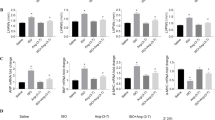Abstract
The nonpeptide AVE0991 is expected to be a putative new drug for cardiovascular diseases. However, the mechanisms for the cardioprotective actions of AVE0991 are still not fully understood. We planned to determine whether AVE0991 attenuates the angiotensin II (AngII)-induced myocardial hypertrophy and whether these AVE0991 effects involved transforming growth factor β1 (TGF-β1) and Smad2. A rat model of neonatal myocardial hypertrophy was induced by AngII. The AngII group significantly increased in protein content, surface area, and [3H]leucine incorporation efficiency by cardiomyocytes, compared to those of the control group (P < 0.01). The AngII group also had elevated TGF-β1 and Smad2 expression (P < 0.01). These AngII-induced changes were significantly attenuated by AVE0991 in a dose-dependent manner. In our study, these actions of AngII (10−6 mol/l) were significantly inhibited by both concentrations of AVE0991 (10−5 mol/l and 10−7 mol/l). Moreover, the high AVE0991 group had significantly better inhibition of myocardial hypertrophy than the low AVE0991 group. Meanwhile, the beneficial effects of AVE0991 were completely abolished when the cardiomyocytes were pretreated with Ang-(1–7) receptor antagonist A-779 (10−6 mol/l). These results suggested that AVE0991 prevented AngII-inducing myocardial hypertrophy in a dose-dependent fashion, a process that may be associated with the inhibition of TGF-β1/Smad2 signaling.
Similar content being viewed by others
References
Park EY, Ahn HM, Lee JA, Lee JA, Hong YM (2009) Insertion/deletion polymorphism of angiotensin converting enzyme gene in Korean hypertensive adolescents. Heart Vessels 24:193–198
Fernandes-Santos C, Mendonca LD, Mandarim-de-Lacerda CA (2009) Favorable cardiac and aortic remodeling in olmesartantreated spontaneously hypertensive rats. Heart Vessels 24: 219–227
Santos RA, Campagnole-Santos MJ, Andrade SP (2000) Angiotensin-(1–7): an update. Regul Pept 91(1-3):45–62
Ferrario CM, Chappell MC, Dean RH, Iyer SN (1998) Novel angiotensin peptides regulate blood pressure, endothelial function, and natriuresis. J Am Soc Nephrol 9(9):1716–1722
Zohn IE, Symons M, Chrzanowska-Wodnicka M, Westwick JK, Der CJ (1998) Mas oncogene signaling and transformation require the small GTP-binding protein Rac. Mol Cell Biol 18(3): 1225–1235
Santos RAS, Simoes e Silva AC, Maric C, Silva DMR, Machado RP, de Buhr I, Heringer-Walther S, Pinheiro SVB, Lopes MT, Bader M, Mendes EP, Soares Lemos V, Campagnole-Santos MJ, Schultheiss H-P, Speth R, Walther T (2003) Angiotensin-(1–7) is an endogenous ligand for the G protein-coupled receptor Mas Proc Natl Acad Sci USA 100(14): 8258–8263
Simões e Silva AC, Bello AP, Baracho NC, Khosla MC, Santos RA (1998) Diuresis and natriuresis produced by long term administration of a selective angiotensin(1–7) antagonist in normotensive and hypertensive rats. Regul Pept 74:177–184
Wiemer G, Dobrucki LW, Louka FR, Malinski T, Heitsch H (2002) AVE 0991, a nonpeptide mimic of the effects of angiotensin-(1–7) on the endothelium. Hypertension 40(6):847–852
Gray MO, Long CS, Kalinyak JE, Li HT, Karliner JS (1998) Angiotensin II stimulates cardiac myocyte hypertrophy via paracrine release of TGF-beta 1 and endothelin-1 from fibroblasts. Cardiovasc Res 40(2):352–363
Seo D, Hare JM (2007) The transforming growth factor-beta/Smad3 pathway: coming of age as a key participant in cardiac remodeling. Circulation 116(19):2096–2098
Khan R, Sheppard R (2006) Fibrosis in heart disease: understanding the role of transforming growth factor-beta in cardiomyopathy, valvular disease and arrhythmia. Immunology 118(1):10–24
Singh BP, Sridhara S, Arora N, Gangal SV (1992) Evaluation of protein assay methods for pollen and fungal spore extracts. Biochem Int 27(3):477–484
Toraason M, Krueger JA, Busch KA, Shaw PB (1990) Automated surface area measurement of cultured cardiac myocytes. Cytotechnology 4(2):155–161
Pinheiro SV, Simoes e Silva AC, Sampaio WO, de Paula RD, Mendes EP, Bontempo ED, Pesquero JB, Walther T, Alenina N, Bader M, Bleich M, Santos RA (2004) Nonpeptide AVE 0991 is an angiotensin-(1–7) receptor Mas agonist in the mouse kidney. Hypertension 44(4):490–496
Iwata M, Cowling RT, Gurantz D, Moore C, Zhang S, Yuan JX, Greenberg BH (2005) Angiotensin-(1–7) binds to specific receptors on cardiac fibroblasts to initiate antifibrotic and antitrophic effects. Am J Physiol Heart Circ Physiol 289(6):H2356–H2363
Loot AE, Roks AJ, Henning RH, Tio RA, Suurmeijer AJ, Boomsma F, van Gilst WH (2002) Angiotensin-(1–7) attenuates the development of heart failure after myocardial infarction in rats. Circulation 105(13):1548–1550
Danilczyk U, Penninger JM (2006) Angiotensin-converting enzyme II in the heart and the kidney. Circ Res 98(4):463–471
Baker KM, Aceto JF (1990) Angiotensin II stimulation of protein synthesis and cell growth in chick heart cells. Am J Physiol 259: 610–618
Bujak M, Frangogiannis NG (2007) The role of TGF-beta signaling in myocardial infarction and cardiac remodeling. Cardiovasc Res 74(2):184–195
Wenzel S, Taimor G, Piper HM, Schlüter K-D (2001) Redoxsensitive intermediates mediate angiotensin II-induced p38 MAP kinase activation, AP-1 binding activity, and TGF-b expression in adult ventricular cardiomyocytes, FASEB J 15:2291–2293
Grobe JL, Mecca AP, Lingis M, Shenoy V, Bolton TA, Machado JM, Speth RC, Raizada MK, Katovich MJ (2007) Prevention of angiotensin II-induced cardiac remodeling by angiotensin-(1–7). Am J Physiol Heart Circ Physiol 292(2):H736–H742
Author information
Authors and Affiliations
Corresponding author
Rights and permissions
About this article
Cite this article
He, JG., Chen, SL., Huang, YY. et al. The nonpeptide AVE0991 attenuates myocardial hypertrophy as induced by angiotensin II through downregulation of transforming growth factor-β1/Smad2 expression. Heart Vessels 25, 438–443 (2010). https://doi.org/10.1007/s00380-009-1213-7
Received:
Accepted:
Published:
Issue Date:
DOI: https://doi.org/10.1007/s00380-009-1213-7




